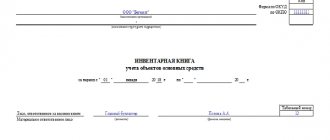Fixed assets involved in the production process gradually lose their original characteristics. Physical wear and tear refers to the deterioration of the technical, economic and social characteristics of an object under the influence of the labor process (intensity, features of technology of use, quantity and quality of repairs, level of aggressiveness of the external environment, etc.). Obsolescence (depreciation) is manifested in the fact that the main asset, in its design, productivity, and efficiency, no longer meets the requirements for producing products of the required quality.
Due to physical or moral wear and tear of a fixed asset, it becomes incapable of producing economic benefits, and this is already grounds for its write-off.
Preparation of documentation for disposal of objects
To establish physical and moral deterioration and whether restoration of the object is possible, whether it will be effective and how advisable its further use is, a commission is created by order of the head of the organization. In the future, she gives her opinion and draws up documentation when disposing of objects.
The commission includes relevant officials, including the chief accountant (accountant) and persons who are responsible for the safety of fixed assets. To participate in the work of the commission, you can invite third-party specialists (clause 77 of the Methodological Guidelines for Accounting of Fixed Assets, approved by Order of the Ministry of Finance of the Russian Federation dated October 13, 2003 No. 91n, hereinafter referred to as the Guidelines).
The commission must (clause 78 of the Guidelines):
- inspect the fixed asset subject to write-off using the necessary technical documentation and accounting data;
- identify persons through whose fault the premature disposal of fixed assets occurs, make proposals to bring these persons to justice;
- draw up conclusions on the write-off of fixed assets.
An order to create a commission may look like this.
The commission also decides whether it is possible to continue to use individual components, parts, materials obtained during the dismantling of a retired facility (for example, for routine repairs of working equipment or for sale), evaluates it by quantity and cost, based on market prices, and also ensures safety.
After making a decision to write off an object, the commission draws up a conclusion. There is no standard form for it. Therefore, you can develop a document template yourself. The main thing is that the form contains all the necessary details of the primary document. The form is approved by the manager by order to the accounting policy (Article 9 of the Federal Law of December 6, 2011 No. 402-FZ, clause 4 of PBU 1/2008).
An example of the conclusion of the liquidation commission.
The next step: the head of the organization issues an order to liquidate the fixed asset. There is no standard form of the document; you can use a sample.
After the conclusion of the commission and the order of the manager, it is necessary to draw up an act on the write-off of the property. You can use the standard form No. OS-4 (for cars - No. OS-4a) or a self-developed form. In the second case, it is necessary that the document contains all the necessary details.
Like any other primary documents used in the organization, the selected form is approved by order of the manager.
Based on write-off acts, make notes on the disposal of fixed assets in inventory cards and books that you use to record the storage and movement of fixed assets. This is provided for in paragraph 80 of the Methodological Instructions. As a rule, standard forms are used: an inventory card in form No. OS-6 (when accounting for property separately) or a card in form No. OS-6a (when fixed assets are accounted for as part of groups of objects). Small enterprises use an inventory book according to form No. OS-6b.
When dismantling a fixed asset, you can obtain individual materials, components and assemblies suitable for use. Such property must be capitalized (clause 57 of the Methodological Instructions). To register the receipt of objects received during the dismantling of fixed assets, you can use standard form No. M-35.
Capitalization of scrap metal from write-off of fixed assets
To put scrap on the balance sheet of a company, it is necessary to draw up an act of capitalization of material assets.
Sample act for the receipt of scrap metal :
The document must contain the nominal value of the metal that is included in the balance sheet. Ideally, it is determined based on current LME (London Metal Exchange) quotes, but prices from other official sources are also suitable.
The document specifies the weight of the scrap (at least approximate), its characteristics and indicates the date of its acceptance on the balance sheet.
How to reflect dismantling in accounting
When liquidating an asset as a result of dismantling, both income and expenses arise. Let's look at how to reflect them in accounting.
Write-off of an object
Write off the object itself from account 01. Also reflect all expenses associated with the liquidation of property. Starting from the month following the liquidation, stop accruing depreciation (clause 22 of PBU 6/01).
If the useful life has not yet expired, when the asset is liquidated, its residual value is written off as other expenses. Do this in the period when you have drawn up the liquidation act and completed all the necessary formalities. This follows from paragraph 29 of PBU 6/01 and paragraph 11 of PBU 10/99.
When writing off the residual value of the transaction, the following are:
DEBIT 02 CREDIT 01 subaccount “Disposal of fixed assets”
— reflects the amount of depreciation accrued during the period of operation of the facility;
DEBIT 01 subaccount “Disposal of fixed assets” CREDIT 01
— the initial cost of the liquidated fixed asset is reflected;
DEBIT 91-2 CREDIT 01 subaccount “Disposal of fixed assets”
— the residual value of the fixed asset is written off (based on the write-off act).
If the residual value is written off optionally, then the costs of disassembly and dismantling cannot be avoided.
Reflect these expenses as part of other expenses for the period to which they relate (clause 31 of PBU 6/01, clause 11 of PBU 10/99).
The recording of the expenses for this work depends on who carries out the liquidation of the fixed asset. There are three options.
Option 1. Liquidation is carried out by a special division of the organization.
For example, a repair service. Then the wiring is like this:
DEBIT 23 CREDIT 70 (68, 69…)
— expenses for liquidation of fixed assets are reflected;
DEBIT 91-2 CREDIT 23
— expenses for liquidation of fixed assets are written off.
Option 2. The organization does not have a special unit, carry out the liquidation without involving third-party contractors.
Therefore, when writing off expenses for the liquidation of a fixed asset in accounting, make the following entry:
DEBIT 91-2 CREDIT 70 (69, 68, 10...)
— expenses for liquidation of fixed assets are taken into account.
Option 3. The contracted contractor liquidates the fixed asset.
The costs associated with paying for his services are reflected by posting:
DEBIT 91-2 CREDIT 60
— expenses for the liquidation of fixed assets carried out by contract are taken into account;
DEBIT 19 CREDIT 60
— VAT claimed by the contractor who carried out the liquidation of the fixed asset was taken into account.
Accounting for materials received during dismantling
What to do with the remaining materials, for example, completely serviceable spare parts and scrap metal? All these things come at market price. In the future, the materials can be used in production or sold.
For the receipt of materials when dismantling the OS, the wiring is as follows:
DEBIT 10 CREDIT 91-1
— materials received during the liquidation of a fixed asset were capitalized.
Sales of materials (scrap) are reflected in accounting as other income. The cost of sold inventories is written off as other expenses. The wiring is like this:
DEBIT 62 CREDIT 91-1
— revenue from the sale of materials (scrap) is reflected;
DEBIT 91-2 CREDIT 10
— the cost of materials (scrap) is written off.
Income Statement and Notes
In the statement of financial results, the written-off residual value of the dismantled fixed assets is indicated on line 2350 “Other expenses”.
In addition, it is reflected in the notes to the balance sheet and the income statement in the section “Fixed assets” in column 6 “Retired objects”.
Other costs associated with the liquidation of a fixed asset (for example, its dismantling, disassembly, etc.) are also indicated in line 2350 “Other expenses” of the Income Statement.
After disassembling or dismantling the equipment, valuables (parts, components, assemblies) may remain that can be used in production. The accountant must capitalize them at market value (possible sale price). This rule is used in both accounting and tax accounting.
The amount of such income is indicated in line 2340 “Other income” of the income statement.
EXAMPLE OF REFLECTION IN ACCOUNTING AND REPORTING OF DISMANTLING OF
OS Tender JSC dismantled and wrote off the machine due to its obsolescence.
The initial cost of the machine is 130,000 rubles, accrued depreciation is 40,000 rubles. After dismantling, materials and spare parts were received that the company plans to use in the future. Their market value is 50,000 rubles. The costs of dismantling the machine amounted to 10,000 rubles. The dismantling was carried out by the Tender repair shop. The Tender accountant must make the following entries: DEBIT 01 subaccount “Retirement of fixed assets” CREDIT 01
- 130,000 rubles.
– the original cost of the machine is written off; DEBIT 02 CREDIT 01 subaccount “Disposal of fixed assets”
- 40,000 rubles.
– accrued depreciation is written off; DEBIT 91-2 CREDIT 01 subaccount “Disposal of fixed assets”
- 90,000 rubles.
(130,000 – 40,000) – the residual value of the machine is written off; DEBIT 91-2 CREDIT 23
- 10,000 rub.
– expenses for dismantling the machine are written off; DEBIT 10 CREDIT 91-1
- 50,000 rub.
– spare parts remaining after dismantling have been capitalized; DEBIT 99 CREDIT 91-9
- 50,000 rub. (90,000 + 10,000 – 50,000) – the loss from the write-off of the machine is reflected. The amount of expenses for liquidating the machine was 100,000 rubles. (90,000 + 10,000). This amount will be shown on line 2350 of the income statement. Income from liquidation in the amount of RUB 50,000. should be reflected on line 2340 of the income statement.
Receipt of scrap metal in a budget organization
The procedure for removing fixed assets from the balance sheet of a budgetary institution is similar to that in a commercial organization. is also formed , which makes the appropriate decision. But unlike a private enterprise, here the fact of disposal must be thoroughly argued and documented . For this the following can be used:
- expert opinions on the unsuitability of further use of the object;
- certificates from the relevant authorities about the fact of an accident, natural disaster and other precedents that served as the basis for the failure of the OS;
- reports on the nominal value of the asset;
- other papers and forms confirming the unsuitability of the object for further use for its intended purpose.
Unlike private firms, the decision to remove fixed assets from the balance sheet is made by the competent authorities , whose jurisdiction is the enterprise, and not the director (unless the asset was acquired at his expense).
How to take dismantling into account when calculating taxes
If you uninstalled the OS, there are tax implications.
Income tax
When calculating income tax, take into account the costs of liquidation of fixed assets as part of non-operating expenses. This applies to both the residual value of the dismantled fixed assets and expenses in connection with the liquidation of property. The basis is subparagraph 8 of paragraph 1 of Article 265 of the Tax Code of the Russian Federation.
When using the accrual method, take into account the expenses in the period in which the act on the completion of work to liquidate the fixed asset was signed. This follows from subparagraph 3 of paragraph 7 of Article 272 of the Tax Code of the Russian Federation.
Using the cash method, reflect liquidation costs as they are paid, provided there is an act of completion of liquidation work (clause 3 of Article 273 of the Tax Code of the Russian Federation). Both under the accrual method and under the cash method, underaccrued depreciation is written off on the date of execution of the act of write-off of the fixed asset.
If after dismantling the remaining parts or materials are capitalized, then their cost should be reflected in non-operating income based on paragraph 13 of Article 250 of the Tax Code of the Russian Federation. It is necessary to show income regardless of whether the received property will be used in the future in activities aimed at generating income or not (letter of the Ministry of Finance of Russia dated May 19, 2008 No. 03-03-06/2/58).
Under the accrual method, the date of receipt of income will be considered the date of signing the act of liquidation of the fixed asset (subclause 8, clause 4, article 271 of the Tax Code of the Russian Federation). If you use the cash method, reflect income in the form of the cost of raw materials or materials received after the liquidation of the fixed asset, on the date of their capitalization in accounting (clause 2 of Article 273 of the Tax Code of the Russian Federation).
The cost at which raw materials, materials, etc. are reflected in tax accounting, should be determined taking into account market prices. In tax accounting, this will be non-operating income.
When releasing materials into production or subsequent sales, reflect their cost, respectively, as part of material expenses or sales expenses. In this case, the cost that can be taken into account when calculating income tax is defined as the amount that was previously taken into account as part of income (paragraph 2, paragraph 2, article 254 of the Tax Code of the Russian Federation).
Special modes
For firms and entrepreneurs on the simplified tax system with the object “income,” the dismantling of fixed assets does not in any way affect the amount of the single tax (clause 3.1 of article 346.21 of the Tax Code of the Russian Federation). Simplified people with the object “income minus expenses” can write off for tax purposes the costs of dismantling the OS either on their own or with the participation of a contractor (Clause 1 of Article 346.16 of the Tax Code of the Russian Federation).
The dismantling of fixed assets does not affect the amount of UTII, because the base for the single tax is imputed income (Article 346.29 of the Tax Code of the Russian Federation).
Sales of scrap ferrous metals
Is VAT subject?
Current tax legislation exempts enterprises from paying value added tax when delivering scrap metal only if it was generated during the company's activities.
Written-off fixed assets can be sold to specialized companies without charging VAT by the state.
This type of transaction does not require the seller to have a license for scrap ferrous metals or other permits.
Below is a sample acceptance certificate that can be filled out when selling (purchasing) scrap ferrous metals:
All acts of scrap metal write-off are then entered into the Book of Acceptance and Delivery Acts.
Tenders
Auctions are an effective means of obtaining the maximum possible profit from the sale of scrap ferrous metals obtained as a result of the liquidation of fixed assets. A tender is justified if the object of sale is of significant material value and arouses interest among a potential buyer. For the sake of two tons of scrap metal, this procedure is not worth undertaking.
The auction begins with the preparation of tender documentation . For this purpose, design organizations may be involved. The composition of the document package may vary, but usually it contains the following elements:
- invitation to bidders;
- information about the auction item: in the context of scrap - this is its weight, class, chemical composition, dimensions;
- application forms and instructions to offerors;
- rules and procedure for holding a tender;
- draft agreement with the winner.
Read about the types of ferrous scrap metal here. Do you want to sell scrap at a good price? Find out everything about ferrous metal collection points. You can read about searching and digging for ferrous metal with a metal detector at this link -
Export of ferrous metal scrap
Selling scrap for export is a rather complicated procedure from the point of view of customs legislation. implement it you will need:
- Calculate customs duties.
- Obtain radiation control and explosion safety .
- Create conditions for inspection in the form of a temporary customs control zone.
- Provide the opportunity for inspectors to conduct customs inspections.
- Select samples for testing in the laboratory for chemical composition.
- Prepare an evidence base to confirm the declared value of the goods.
In addition, the following documents will be needed to present to inspectors:
- contract with the buyer; if the amount of the supply agreement is more than fifty thousand dollars, a transaction passport will also be needed;
- constituent documents;
- invoice or invoice;
- waybills - you will need a TTN, CMR or bill of lading depending on the selected type of transportation;
- confirmation of the classification code according to the Commodity Nomenclature of Foreign Economic Activity;
- packing list;
- payment documents confirming payment for goods;
- checks confirming payment of customs duties;
- If there are benefits , their confirmation will also be required.
Contacting a specialized organization that provides customs brokerage services will significantly simplify the registration procedure, but will also require additional costs.




